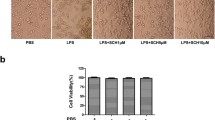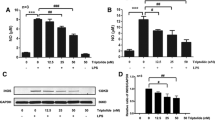Abstract
Pathogens such as bacterial lipopolysaccharide (LPS) play an important role in promoting the production of the inflammatory cytokines interleukin-1 beta (IL-1β) and tumour necrosis factor-α (TNF-α) in response to infection or damage in microglia. However, whether different signalling pathways regulate these two inflammatory factors remains unclear. The protein kinase C (PKC) family is involved in the regulation of inflammation, and our previous research showed that the activation of the PKC pathway played a key role in the LPS-induced transformation of the adenosine A2A receptor (A2AR) from anti-inflammatory activity to pro-inflammatory activity under high glutamate concentrations. Therefore, in the current study, we investigated the role of PKC in the LPS-induced production of these inflammatory cytokines in mouse primary microglia. GF109203X, a specific PKC inhibitor, inhibited the LPS-induced expression of IL-1β messenger ribonucleic acid and intracellular protein in a dose-dependent manner. Moreover, 5 µM GF109203X prevented LPS-induced IL-1β expression but did not significantly affect LPS-induced TNF-α expression. PKC promoted IL-1β expression by regulating the activity of NF-κB but did not significantly impact the activity of ERK1/2. A2AR activation by CGS21680, an A2AR agonist, facilitated LPS-induced IL-1β expression through the PKC pathway at high glutamate concentrations but did not significantly affect LPS-induced TNF-α expression. Taken together, these results suggest a new direction for specific intervention with LPS-induced inflammatory factors in response to specific signalling pathways and provide a mechanism for A2AR targeting, especially after brain injury, to influence inflammation by interfering with A2AR.






Similar content being viewed by others
Abbreviations
- LPS:
-
Lipopolysaccharide
- IL-1β:
-
Interleukin-1 beta
- TNF-α:
-
Tumour necrosis factor-α
- TBI:
-
Traumatic brain injury
- NF-κB:
-
Nuclear factor- kappa-B
- A2AR:
-
Adenosine A2A receptor
- ERK1/2:
-
Extracellular regulated protein kinases 1/2
- MAPK:
-
Mitogen-activated protein kinase
- TLR4:
-
Toll-like receptor 4
- MyD88:
-
Myeloid differentiation primary response 88
- Iba-1:
-
Ionized calcium-binding adaptor molecule 1
- DABK:
-
des-Arginine9-bradykinin
References
Bachiller S et al (2018) Microglia in neurological diseases: a road map to brain-disease dependent-inflammatory response. Front Cell Neurosci 12:488
Kettenmann H et al (2011) Physiology of microglia. Physiol Rev 91(2):461–553
Norris GT, Kipnis J (2019) Immune cells and CNS physiology: microglia and beyond. J Exp Med 216(1):60–70
Ransohoff RM (2016) How neuroinflammation contributes to neurodegeneration. Science 353(6301):777–783
Moller B, Villiger PM (2006) Inhibition of IL-1, IL-6, and TNF-alpha in immune-mediated inflammatory diseases. Springer Semin Immunopathol 27(4):391–408
Li T et al (2019) Synergistic anti-inflammatory effects of quercetin and catechin via inhibiting activation of TLR4-MyD88-mediated NF-kB and MAPK signaling pathways. Phytother Res 33(3):756–767
Huang X et al (2009) An atypical protein kinase C (PKC zeta) plays a critical role in lipopolysaccharide-activated NF-kB in human peripheral blood monocytes and macrophages. J Immunol 182(9):5810–5815
Taupin V et al (1993) Increase in IL-6, IL-1 and TNF levels in rat brain following traumatic lesion. Influence of pre- and post-traumatic treatment with Ro5 4864, a peripheral-type (p site) benzodiazepine ligand. J Neuroimmunol 42(2):177–185
Dalgard CL et al (2012) The cytokine temporal profile in rat cortex after controlled cortical impact. Front Mol Neurosci 5:6
Newton AC (2018) Protein kinase C: perfectly balanced. Crit Rev Biochem Mol Biol 53(2):208–230
Garcia-Bernal F et al (2018) Protein kinase C inhibition mediates neuroblast enrichment in mechanical brain injuries. Front Cell Neurosci 12:462
Zhao EY et al (2016) The role of Akt (protein kinase B) and protein kinase C in ischemia–reperfusion injury. Neurol Res 38(4):301–308
Ma Y et al (2015) Protein kinase cα regulates the expression of complement receptor Ig in human monocyte-derived macrophages. J Immunol 194(6):2855–2861
Yu W et al (2017) Fumigaclavine C exhibits anti-inflammatory effects by suppressing high mobility group box protein 1 relocation and release. Eur J Pharmacol 812:234–242
Gordon R et al (2016) Protein kinase Cδ upregulation in microglia drives neuroinflammatory responses and dopaminergic neurodegeneration in experimental models of Parkinson's disease. Neurobiol Dis 93:96–114
Sejimo S, Hossain MS, Akashi K (2018) Scallop-derived plasmalogens attenuate the activation of PKCδ associated with the brain inflammation. Biochem Biophys Res Commun 503(2):837–842
Yang J et al (2015) Perfluorooctane sulfonate mediates microglial activation and secretion of TNF-α through Ca(2)(+)-dependent PKC-NF-small ka, CyrillicB signaling. Int Immunopharmacol 28(1):52–60
Kim DC et al (2005) Effect of rottlerin, a PKC-δ inhibitor, on TLR-4-dependent activation of murine microglia. Biochem Biophys Res Commun 337(1):110–115
Santiago AR et al (2014) Role of microglia adenosine A(2A) receptors in retinal and brain neurodegenerative diseases. Mediators Inflamm 2014:465694
Dai SS et al (2010) Local glutamate level dictates adenosine A2A receptor regulation of neuroinflammation and traumatic brain injury. J Neurosci 30(16):5802–5810
Dai SS et al (2013) Plasma glutamate-modulated interaction of A2AR and mGluR5 on BMDCs aggravates traumatic brain injury-induced acute lung injury. J Exp Med 210(4):839–851
Wardas J, Konieczny J, Pietraszek M (2003) Influence of CGS 21680, a selective adenosine A(2A) agonist, on the phencyclidine-induced sensorimotor gating deficit and motor behaviour in rats. Psychopharmacology 168(3):299–306
Saura J et al (2005) Adenosine A2A receptor stimulation potentiates nitric oxide release by activated microglia. J Neurochem 95(4):919–929
Papa S et al (2013) Selective nanovector mediated treatment of activated proinflammatory microglia/macrophages in spinal cord injury. ACS Nano 7(11):9881–9895
Nakajima K et al (2003) Activation of microglia with lipopolysaccharide leads to the prolonged decrease of conventional protein kinase C activity. Brain Res Mol Brain Res 110(1):92–99
Sharma N, Sharma S, Nehru B (2017) Curcumin protects dopaminergic neurons against inflammation-mediated damage and improves motor dysfunction induced by single intranigral lipopolysaccharide injection. Inflammopharmacology 25(3):351–368
Jayaprakash K et al (2017) PKC, ERK/p38 MAP kinases and NF-kB targeted signalling play a role in the expression and release of IL-1β and CXCL8 in Porphyromonas gingivalis-infected THP1 cells. APMIS 125(7):623–633
Hua KF et al (2012) High glucose increases nitric oxide generation in lipopolysaccharide-activated macrophages by enhancing activity of protein kinase C-α/δ and NF-kB. Inflamm Res 61(10):1107–1116
Song XM et al (2017) Aldose reductase inhibitors attenuate β-amyloid-induced TNF-α production in microlgia via ROS-PKC-mediated NF-kB and MAPK pathways. Int Immunopharmacol 50:30–37
Shin EJ et al (2016) PKCδ knockout mice are protected from para-methoxymethamphetamine-induced mitochondrial stress and associated neurotoxicity in the striatum of mice. Neurochem Int 100:146–158
Hoogland IC et al (2015) Systemic inflammation and microglial activation: systematic review of animal experiments. J Neuroinflammation 12:114
Norden DM et al (2016) Sequential activation of microglia and astrocyte cytokine expression precedes increased Iba-1 or GFAP immunoreactivity following systemic immune challenge. Glia 64(2):300–316
Sun X et al (2018) Glycyrrhizin ameliorates inflammatory pain by inhibiting microglial activation-mediated inflammatory response via blockage of the HMGB1-TLR4-NF-kB pathway. Exp Cell Res 369(1):112–119
Markoutsa E, Xu P (2017) Redox potential-sensitive N-acetyl cysteine-prodrug nanoparticles inhibit the activation of microglia and improve neuronal survival. Mol Pharm 14(5):1591–1600
Meotti FC et al (2017) The transient receptor potential ankyrin-1 mediates mechanical hyperalgesia induced by the activation of B1 receptor in mice. Biochem Pharmacol 125:75–83
Hsia CH et al (2018) Mechanisms of TQ-6, a novel ruthenium-derivative compound, against lipopolysaccharide-induced in vitro macrophage activation and liver injury in experimental mice: the crucial role of p38 MAPK and NF-kB signaling. Cells 7(11):217
Muili KA et al (2013) Pancreatic acinar cell nuclear factor kB activation because of bile acid exposure is dependent on calcineurin. J Biol Chem 288(29):21065–21073
Chai W et al (2013) Pyocyanin from Pseudomonas induces IL-8 production through the PKC and NF-kappaB pathways in U937 cells. Mol Med Rep 8(5):1404–1410
Shi Y et al (2017) Activated niacin receptor HCA2 inhibits chemoattractant-mediated macrophage migration via Gβγ/PKC/ERK1/2 pathway and heterologous receptor desensitization. Sci Rep 7:42279
Mohanraj M et al (2018) The mycobacterial adjuvant analogue TDB attenuates neuroinflammation via mincle-independent PLC-gamma1/PKC/ERK signaling and microglial polarization. Mol Neurobiol 56(2):1167–1187
Kontny E et al (2000) Rottlerin, a PKC isozyme-selective inhibitor, affects signaling events and cytokine production in human monocytes. J Leukoc Biol 67(2):249–258
Pham TH et al (2017) Fargesin exerts anti-inflammatory effects in THP-1 monocytes by suppressing PKC-dependent AP-1 and NF-kB signaling. Phytomedicine 24:96–103
He X et al (2012) Inhibitory effect of Astragalus polysaccharides on lipopolysaccharide-induced TNF-a and IL-1β production in THP-1 cells. Molecules 17(3):3155–3164
Talwar H et al (2017) MKP-1 negatively regulates LPS-mediated IL-1β production through p38 activation and HIF-1α expression. Cell Signal 34:1–10
Gomes CV et al (2011) Adenosine receptors and brain diseases: neuroprotection and neurodegeneration. Biochim Biophys Acta 1808(5):1380–1399
Madeira MH et al (2015) Adenosine A2AR blockade prevents neuroinflammation-induced death of retinal ganglion cells caused by elevated pressure. J Neuroinflammation 12:115
Borroto-Escuela DO et al (2018) Understanding the role of adenosine A2AR heteroreceptor complexes in neurodegeneration and neuroinflammation. Front Neurosci 12:43
Chiu GS et al (2014) Adenosine through the A2A adenosine receptor increases IL-1β in the brain contributing to anxiety. Brain Behav Immun 41:218–231
Acknowledgements
This work was supported by the Scientific Research Foundation for the Returned Overseas Chinese Scholars, State Education Ministry.
Author information
Authors and Affiliations
Corresponding author
Ethics declarations
Conflict of interest
The authors declare that they have no conflicts of interest.
Additional information
Publisher's Note
Springer Nature remains neutral with regard to jurisdictional claims in published maps and institutional affiliations.
Electronic supplementary material
Below is the link to the electronic supplementary material.
Supplementary Fig. 1
Inhibition of PKC abrogates changes in microglial morphology after LPS stimulation. Morphological changes with LPS stimulation in microglia after PKC inhibition (a). Nuclei are labelled with DAPI (blue), and Iba-1 is indicated by red fluorescence; scale bar = 50 µm. Evaluation of microglial cell sphericity (an index of cell activation) in four different groups.*P < 0.05 and **P < 0.01 compared with the LPS stimulation group; #P < 0.05 and ##P < 0.01 compared with the untreated control group. Supplementary material 1 (TIF 7591.1 kb)
Rights and permissions
About this article
Cite this article
Fu, SY., Xiong, RP., Peng, Y. et al. PKC Mediates LPS-Induced IL-1β Expression and Participates in the Pro-inflammatory Effect of A2AR Under High Glutamate Concentrations in Mouse Microglia. Neurochem Res 44, 2755–2764 (2019). https://doi.org/10.1007/s11064-019-02895-1
Received:
Revised:
Accepted:
Published:
Issue Date:
DOI: https://doi.org/10.1007/s11064-019-02895-1




